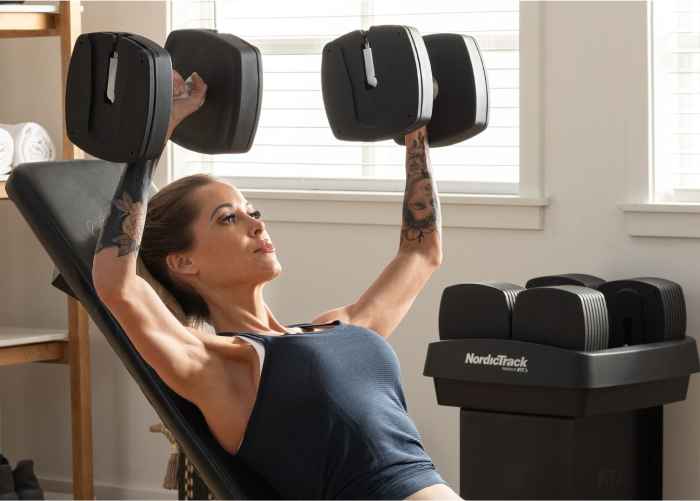
Have you ever wondered: What training style is best for longevity?
Is cardio or strength training better for longevity?
If those questions have come up for you, this article comparing cardio vs. strength training for longevity is for you.
That’s because we’re answering those questions along with the following:
- What is the number one exercise for longevity?
- Does strength training increase lifespan?
- Is weightlifting better than cardio for long-term health?
We’ll also share what may happen to your body and your health when you’re inactive, the benefits of exercising, and how much exercise you should aim for to improve health and longevity.
Exercise and Longevity: Everything You Need to Know, According to Research
Before we get to the differences between cardio and strength training for longevity, we’ll first discuss how being active or inactive impacts your health, starting with:
Here’s What Happens When You’re Inactive
Being inactive and living a sedentary lifestyle is one of the worst things you can do for your health and longevity.
In the short term, it can lead to:
1. Decreased calorie burn and unwanted weight gain1. Your body will burn fewer calories at rest, which can lead to weight gain.
2. Decreased muscle strength1. When you don’t use your muscles enough, they’ll start to lose their strength and size.
3. Reduced bone density1. You’ll begin to lose essential minerals from your bones, which decreases their density and can cause your bones to become brittle.
4. Decreased metabolism1. On top of burning fewer calories, your body will also struggle to properly metabolize fats and sugars, which can negatively affect your metabolism.
5. Compromised immune system1. Your immune system’s effectiveness may decrease over time, leaving you more susceptible to illnesses.
6. Inefficient blood circulation1. Without enough physical activity each day, you’ll impede proper blood flow.
7. Increased inflammation1. Being inactive may lead to increased inflammation levels in the body.
According to the National Library of Medicine via MedlinePlus1, these issues can snowball into much more significant concerns and may lead to conditions such as:
- Metabolic syndrome
- Type 2 diabetes
- Heart disease
- High blood pressure
- High cholesterol
- Obesity
- Stroke
- Osteoporosis
- Depression and anxiety
How Exercise and Staying Active Can Help Improve Longevity

Conversely, when you are consistently active, you can help improve your quality of life and longevity.
Research in Johns Hopkins Medicine noted, “Exercise just may be the closest thing we have to a fountain of youth. Besides lowering your risk of various diseases, it can even prevent some age-related changes in your DNA2.”
According to a Harvard T.H. Chan School of Public Health study, engaging in 150 minutes of moderate-intensity exercise per week is linked to having an increased lifespan3.
Regularly engaging in physical activity also benefits heart health since it can slash your risk of developing heart disease4.
That’s because exercise may help4:
1. Reduce blood pressure. Aiming for 30 to 60 minutes of moderate aerobic exercise daily may decrease blood pressure4.
2. Decrease cholesterol. Regular physical activity may help lower the “bad” cholesterol known as LDL4.
On top of that, engaging in regular physical activity may help you burn more calories, prevent weight gain, maintain a healthy weight, and even shed pounds4,5.
According to the Mayo Clinic, getting enough exercise each day may help5:
- Boost your mood
- Improve energy levels
- Improve your sleep
All of this may help add years to your lifespan and help prevent chronic health conditions like these from developing5:
- Type 2 diabetes
- Metabolic syndrome
- High blood pressure
- Stroke
- Depression and anxiety
Lastly, the good news is that you don’t have to spend hours at the gym to reap these incredible health benefits (more on this shortly).
According to a study from JAMA Internal Medicine presented in an article from the Harvard School of Medicine, incorporating short bursts of activity throughout your day may be enough to increase longevity and lifespan6.
The research discovered that engaging in as little as ten extra minutes of moderate-intensity activity per day led to a 7% decrease in the death risk6.
Twenty additional minutes increased to a 13% drop in deaths, while 30 minutes produced a 17% reduction6.
So if you can’t make a 45-minute or hour exercise session work, weaving in shorter 15- or 20-minute workout bursts throughout your day may prove just as beneficial.
Now that you know what happens when you’re inactive and the difference it makes when you exercise, the next question becomes: What training style is best for longevity?
To answer that question, we’re diving into each style of exercising individually before making a firm conclusion:
The Benefits of Cardio Workouts on Longevity, According to Research

According to research published in Harvard Health, your level of aerobic fitness plays a crucial role in extending your lifespan7.
Using a retrospective study published in JAMA, researchers sought to uncover how study participants’ cardiovascular fitness (CRF) level was associated with mortality rates7.
CRF is measured by assessing how efficiently the heart and lungs of study participants circulate blood and oxygen throughout the body during bouts of exercise7.
Looking at 122,000 study participants aged 18 to 80, researchers discovered that those with a higher CRF level were associated with living longer than those with lower scores regardless of age7.
Interestingly, “the higher the level of CRF, the higher the survival rate,” according to the research, and this remarkable finding was observed in study participants who were older and in those with high blood pressure7.
They also found that regular exercise and engaging in vigorous physical activity both increased levels of CRF.7
The key takeaway from this research is that maintaining a high degree of physical fitness is good for both your health and longevity.
Another study, published by the British Journal of Sports Medicine, reviewed exercise surveys of 100,000 participants aged 55 to 74.
Both men and women in the study reported on how often they exercised, how long they did it for, and the type of exercise they did.
After reviewing the data and following up after nine years, researchers concluded that engaging in moderate to vigorous aerobic exercise reduced the risk of dying by 24% to 34% 8.
You may be able to achieve those life-extending results by engaging in 150 to 300 minutes of moderate aerobic activity per week, including biking, walking, or swimming, according to research published in Harvard Health7.

Additional research found in MedlinePlus echoes this amount of cardio per week, this time to improve heart health.
According to the National Library of Medicine via MedlinePlus, “Aerobic exercise is the best type for your heart4,” and they define this form of working out as anything that gets your heart pumping and utilizes the large muscle groups of the body.
Activities like hiking, cycling, walking, dancing, tennis, swimming, etc., all use the large muscle groups found in the legs, including your quadriceps, hamstrings, glutes, and calves, making all these great exercises to weave in throughout your week.
If you’ve ever wondered, does strength training increase lifespan? Or, is weightlifting better than cardio for long-term health? This next section will help answer those questions and more.
The Benefits of Strength Training for Longevity, According to Research

While cardio is great for your health and longevity, so is strength training.
A study published by JAMA Network Open and presented in Harvard Health looked at exercise data across eight years in 115,000 study participants.
They compared this information to the average deaths during that time and found that “participants who did strength training two to six times weekly were less likely to die from any cause during the study period compared with those who did less strength training9.”
That same research presented a moment ago by the British Journal of Sports Medicine, which looked at exercise surveys of 100,000 men and women, reported that “weight lifting alone was linked to a 9% to 22% lower risk of dying.8”
While many people think that strength training only helps you get stronger and build more muscle, that’s not its only superpower.
According to two separate articles from Johns Hopkins Medicine, strength training also offers the following health benefits2,10:
- Boosts your overall fitness
- Decreases fat and increases lean body mass
- Increases and protects muscle mass, which increases your metabolism and prevents unwanted weight gain as you age
- Increases your calorie burn
- Strengthens bones
- Improves bone density
- Increases insulin sensitivity
- Decreases cholesterol and blood pressure
- Boosts your mental health
- Improves depression symptoms
According to research in Harvard Health, “The average 30-year-old will lose about a quarter of his or her muscle strength by age 70 and half of it by age 9011.”
That’s why Dr. Robert Schreiber, physician-in-chief at Hebrew SeniorLife and an instructor in medicine at Harvard Medical School, mentions that strength training is crucial as you age11.
Dr. Schreiber said, “Just doing aerobic exercise is not adequate11,” and, “Unless you’re doing strength training, you will become weaker and less functional11.”
Research from the Mayo Clinic echoes Dr. Schreiber’s thoughts.
As you age, there’s a natural decline in lean muscle mass, and if you don’t actively work to counteract this, your body fat will naturally increase over time, according to the Mayo Clinic12.
Fortunately, as that article points out, strength training is one of the best ways to do just that since it preserves muscle mass and helps to strengthen and grow it12.
The even better news is that you can get started with strength training in as little as 20 minutes11 two or three times per week10, according to Harvard Health and Johns Hopkins research.
So, you don’t need to spend hours at the gym to reap these positive perks.
For a 20-minute strength training program that you can do at home, check out iFIT Trainer John Peel’s 20-Minute Build and Burn Series. This strength-focused program coaches you through a mix of upper-body, lower-body, and total-body workouts.
The Verdict: Is Cardio or Strength Better for Longevity?

So, with all that said, what training style is best for longevity?
Is cardio or strength better for longevity?
Combining strength training and aerobic exercise throughout your week may be the key to better health and longevity.
As a quick refresher, the research we touched on throughout this article from the British Journal of Sports Medicine noted a:
- 9% to 22% decreased risk of death in people who only practiced strength training8
- 24% to 34% decrease in death risk when people only engaged in moderate to vigorous aerobic activity8
But even more interesting is that when people practice both strength training and aerobic exercise throughout the week, they saw a whopping 41% to 47% lower risk of death compared to study participants who didn’t exercise at all8.
So, while strength training and aerobic exercises are powerful, they’re even stronger together, doubling the reduction of death risk.
Another study published by JAMA Network Open and presented in Harvard Health found similar results.
Researchers looked at exercise data across eight years in 115,000 study participants.
They compared this information to the average deaths during that time and found that “People who did at least two sessions of strength training as well as 2.5 hours of moderate-to-vigorous aerobic activity each week were 30% less likely to die during that time9.”
It’s important to note that this study was observational, so it did not conclusively determine this outcome, but it is positive to see.
Lastly, a meta-analysis, which reviewed 11 scientific studies, including 370,256 study participants over eight years, found that “resistance training was associated with a 21% and 40% lower all-cause mortality alone and when combined with aerobic exercise, respectively.13”
Mixing strength training and cardio exercises throughout your week may be the key to longevity and better health.
More research would be needed to confirm these findings, but it is an incredible step in the right direction.
How Much Should You Exercise for Longevity?

The current exercise guidelines, as outlined in the Mayo Clinic’s website, suggest14,15:
- At least 150 minutes of aerobic exercise per week or 75 minutes of vigorous aerobic activity per week
- Two to three strength training sessions per week for approximately 20 to 30 minutes
For strength training specifically, they also suggest, “Do strength training exercises for all major muscle groups at least two times per week” and “Use a weight or resistance level heavy enough to tire your muscles after about 12 to 15 repetitions14.”
When it comes to strength training specifically, you don’t need to lift weights exclusively, either.
Using your body weight, resistance bands, cable suspension training, such as TRX, and free weights all count as strength training15.
The Mayo Clinic recommendations also mention that engaging in 30 minutes of moderate-intensity exercise each day is a great starting point and that you may need to bump this up if weight loss is your goal.
Another great tip from the Mayo Clinic is to reduce how often you’re sitting throughout your day since doing so can increase your risk of developing metabolic conditions14.
Lastly, if you’re short on time, you can always break up your exercise to include 10- to 15-minute bursts throughout your day, which is just as effective health-wise14.
Find Both Cardio & Strength Training Programs with iFIT

And, if you’re looking for an easy way to include both cardio and strength training exercises into your weekly routine, check out iFIT, a separate paid subscription service.
iFIT gives you access to thousands of on-demand workouts you can do at home, at the gym, or anywhere else. They’re all led by expert trainers from around the world, and there’s a healthy mix of cardio and strength training options.
You can even join done-for-you workout programs where all you have to do is show up and let the trainer lead the way.
For some excellent beginner series to try, check out the following iFIT series:
- Costa Rica Walking Series with John Peel
- Bodyweight Cardio Series with Ashley Paulson
- Trails to Trees Part 1: Colorado with Paulo Barreto
- Power HIIT and Core: Phase 1 with Casey Gilbert
The Bottom Line
After reading this article, you now know the answer to the question: Is cardio or strength better for longevity?
When it comes to longevity and better health, doing some form of exercise consistently and regularly throughout your day and week is key.
As you saw, there are incredible benefits that come with performing cardio as well as strength training exercises.
And there’s even more of a beneficial boost when you combine the two.
So, instead of choosing between one or the other, try to weave cardio and strength training into your weekly routine, and you may improve your longevity and health along the way.
Resources used in this article:
- https://medlineplus.gov/healthrisksofaninactivelifestyle.html
- https://www.hopkinsmedicine.org/health/wellness-and-prevention/pump-up-your-health
- https://www.hsph.harvard.edu/news/hsph-in-the-news/longevity-exercise-150-minutes/
- https://medlineplus.gov/ency/patientinstructions/000763.htm
- https://www.mayoclinic.org/healthy-lifestyle/fitness/in-depth/exercise/art-20048389
- https://www.health.harvard.edu/staying-healthy/even-small-increases-in-daily-exercise-are-tied-to-longevity
- https://www.health.harvard.edu/blog/can-exercise-extend-your-life-2019031316207
- https://www.health.harvard.edu/heart-health/adding-weight-lifting-to-workouts-may-boost-longevity
- https://www.health.harvard.edu/exercise-and-fitness/adding-strength-training-to-aerobic-exercise-may-fuel-longevity
- https://www.hopkinsallchildrens.org/Patients-Families/Health-Library/HealthDocNew/Strength-Training
- https://www.health.harvard.edu/staying-healthy/want-to-live-longer-and-better-do-strength-training
- https://www.mayoclinic.org/healthy-lifestyle/fitness/in-depth/strength-training/art-20046670
- https://pubmed.ncbi.nlm.nih.gov/31104484/
- https://www.mayoclinic.org/healthy-lifestyle/fitness/expert-answers/exercise/faq-20057916
- https://www.mayoclinic.org/healthy-lifestyle/fitness/in-depth/strength-training/art-20046670
Disclaimer: This blog post is not intended to replace the advice of a medical professional. The above information should not be used to diagnose, treat, or prevent any disease or medical condition. Please consult your doctor before making any changes to your diet, sleep methods, daily activity, or fitness routine. iFIT assumes no responsibility for any personal injury or damage sustained by any recommendations, opinions, or advice given in this article. Always follow the safety precautions included in the owner’s manual of your fitness equipment.


